Are you an aspiring guitarist stuck in a rut of strumming the same repetitive chords? If so, it’s time to break free from your old song patterns and learn the most common guitar chords. Whether you want to blast out some classic rock jams or croon out a folksy melody, having a comprehensive understanding of these essential chords is one of the most important steps every guitarist should take towards mastering their craft. In this blog post, we will explore each chord and its uses in further detail – get ready to take your playing to exciting new musical heights!
What Is a Guitar Chord?
A chord is a group of three or more notes that are played together on a guitar. Chords create the foundation for playing songs and music, as they help to form melodies and provide harmonic accompaniment.
When it comes to learning chords on the guitar, there are some common chords that are essential for every guitarist to learn. These chords will make up the majority of songs you’ll play and are commonly used in all styles of music. Learning these chords will give you a good basis from which to build your guitar-playing skills.
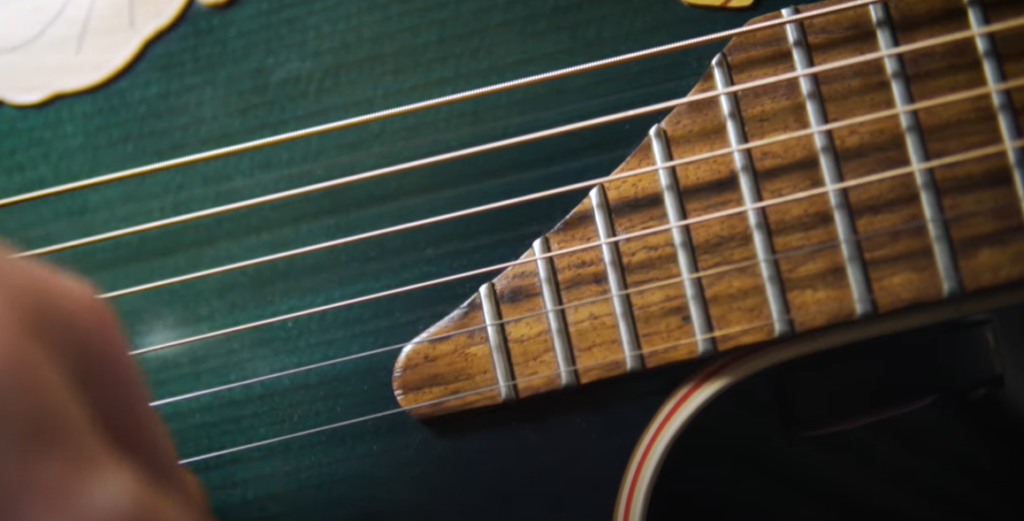
Basic Guitar Chords for Beginners
G Major
This is one of the most basic and common guitar chords. It’s a great chord to start with because it only requires three fingers, which can be easily arranged on the fretboard. To play G major, place your index finger on the third string’s second fret; then press your third finger onto the fifth string and its corresponding second fret. Finally, put your fourth finger on the first fret of the fourth sting.
C Major
The C major chord is a simple, user-friendly guitar chord for newcomers to the instrument. To play this chord, you will need two fingers. Place your index finger on the second string at the first fret and your middle finger on the third string at the second fret. [1]
D Major
Mastering the D, F sharp and A notes will give you access to one of the most widely used chords in guitar playing. When strumming this chord you should be hitting all six strings starting with the thickest string (the low E) and then moving down to the thinnest string (the high e). Make sure that you are using a clean mute on each note. This will give your chord a tight sound. You can also play this same pattern using open strings if desired.
A Major
It is one of the most commonly used guitar chords. This chord consists of three notes—the root note, the third, and the fifth—which are played together to form a Major chord. When playing a Major chord on the guitar, the root note is typically located at the bottom of the fretboard and played with your index finger. The third is then located at the middle of the fretboard, usually played with your middle finger, while the fifth is located at the top of the fretboard, played by your ring finger. Playing this combination of notes produces a bright and cheerful sound that’s often found in popular music.
A Minor
This chord is one of the most common chords used in the guitar. It has a unique sound that can be used in many variations and styles, from rock to jazz. The basic form of this chord consists of just three notes – an A, C, and E – played simultaneously on different strings. Accurately playing an A Minor chord requires you to place your index finger on the fifth string (A note) of the second fret, middle finger on the fourth string (C note) of the second fret, and ring finger on third string’s(E note) second fret. Play all six strings together to create a lush, resonant A Minor chord!
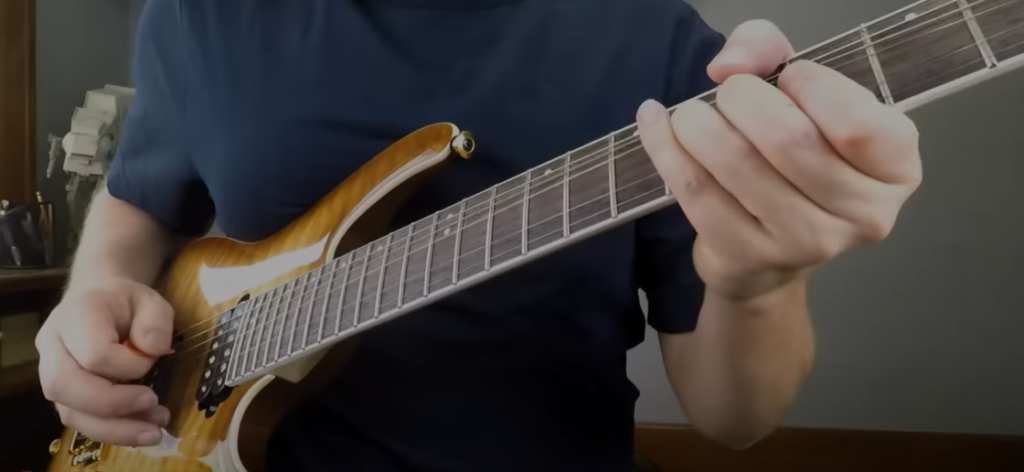
E Major
This chord is a widely-played guitar progression that has an invigorating, cheerful sound. To play the E Major chord perfectly, start by pressing your index finger on the second fret of the sixth string (E note), middle finger onto the second fret of the fifth string (B note), and ring finger on the third fret of fourth string (G sharp). Once you’ve done that, strum all six strings together for a beautiful sound. [2]
E Minor
A cornerstone of the guitar playing world, the E Minor chord is essential to any aspiring musician’s repertoire. A basic three-note chord, comprised of the open E string followed by an F♯ on the 2nd fret of the A string and a B at the second fret of the low E string, is all you need for exceptional harmony. This combination produces a rich sound that can be used as a foundation for many types of music. By adding other notes to this basic structure, you can create more complex chords and progressions which can add texture and depth to your musical arrangements. With its versatility and ease of use, it’s no wonder why this chord is so frequently used!
F Major
The F Major chord is also a frequently seen chord in guitar playing, and it’s one that is often used to add flavor to musical passages. This three-note chord consists of an open E string, followed by an A on the first fret of the D string, and then a C♯ on the second fret of the B string. This combination creates a very bright and cheerful sound that can be used for both strumming patterns and melodic lines. Additionally, you can also use this chord in various progressions to create different moods and colors within your music. So if you’re looking for something new to add some sparkle to your playing, then consider trying out the F Major chord!
B Major
The B Major chord is one of the most common chords used in guitar playing and is a staple of many popular songs. It consists of the notes B, D and F sharp. To play this chord, place your index finger on the second fret of the fifth string, your middle finger on the fourth fret of the fourth string, and your ring finger on the fourth fret of the third string. Strum all six strings to produce a full sound. This chord can be played with various inversions (the order in which you hit each note) to create different sounds as well.
B Minor
The B Minor chord is one of the most commonly used guitar chords. It is an open chord, meaning that it does not require you to use any fingers on frets beyond the open position. To play a B Minor chord, start by placing your index finger on the second fret of the fifth string. Next, place your middle finger on the third fret of the fourth string and your ring finger on the second fret of the third string. Finally, strum all six strings at once. This produces a beautiful sound that can be used in many genres of music from blues to rock and jazz. Additionally, you can use this chord as an alternate voicing for other kinds of chords like A7 or Em7.
F Sharp Major
A classic and preferred chord among guitarists, the F sharp major chord is an invaluable tool for creating captivating music. Get started by placing your index finger on the first fret of the sixth string – that’s all you need to begin playing! Subsequently, press your middle finger down on the second fret of the fourth string and your ring finger onto the third fret of the third string. Finally, pluck all six strings simultaneously to create a mesmerizing melody. This can be used in many genres including rock, blues, jazz and folk music. Additionally, this chord makes a great substitution for other chords such as D7 or B m7. [3]
B Flat Major
Constructing a B flat major chord is effortless, needing only the notes Bb, D and F. Its fingering is analogous to an A major chord which makes this chord quite easy to play on any instrument. To play this chord, place your first finger on the second fret of the A string, middle finger on the third fret of the D string and finally your ring finger at the fourth fret of the G string. This simple arrangement makes for a great sounding chord that can be used in many genres of music. It has also been used extensively in jazz and classical styles, making it one of the most common guitar chords around!
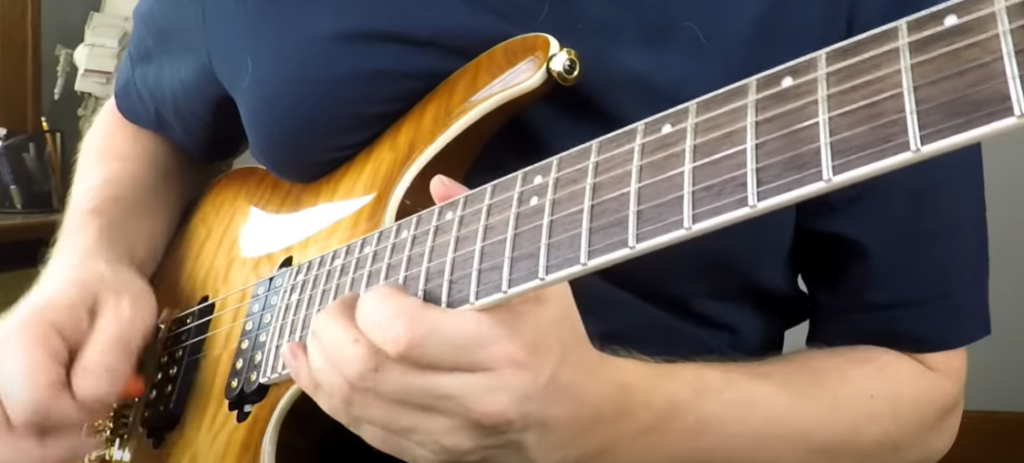
C Sharp Major
To play a C sharp major chord, lay your first finger on the third fret of the A string; second finger on the fourth fret of the D string; and finally place your third finger over the fifth fret of G string. This easy-to-play chord can be incorporated into a myriad of musical genres! The notes make up an interesting combination which makes it stand out from its relatives like A major or B minor. It’s an essential chord to learn because of its popularity in many different genres!
E Flat Major
This four-finger chord begins on the sixth string at the third fret. To begin, press your index finger on the sixth string at the third fret; then put your middle finger on the fifth string’s fourth fret; next place your ring finger on the fourth string third fret; and lastly rest your pinky on the second string at its fourth fret. As an alternate form, you can also use your first and second fingers together for both notes of the root of this chord at the same time. Many beginners find this easier to do than placing each finger separately.
A Flat Major
This five-note chord begins with the sixth string at the first fret. To form this chord, first place your index finger on the sixth string at the first fret; next, slide your middle finger to the fourth string at the third fret; follow this by placing your ring finger onto the third strings second fret; then rest you pinkie on top of the second string in its inaugural fret. Finally, complete with a firm pressure from your thumb or pointer onto that same fretted position of first strings’ second notch. This can also be called A Flat Major Seven, as it includes a seventh interval in addition to the root note and major triad of an A Flat Major chord. [4]
How to Learn Chords?
Mastering chords will undoubtedly take your guitar playing to the next level. With a bit of determination and perseverance, mastering chords can be within reach for anyone! Here are some tips for getting started:
- Start by learning the basics. Familiarize yourself with the most common guitar chords and their finger positions, such as C major, G major, A minor, etc. Having a basic understanding of these will make learning more complex chords much easier.
- Practice regularly. Spend time each day practicing chord progressions, switching between chords and strumming patterns until you are comfortable enough to play them without looking at your hands.
- Learn songs that use the same or similar chords. Not only does this give you a context in which to practice your chords, but it will also help you learn chord progressions and transitions more quickly.
- Experiment with different fingerings. Trying out different finger combinations can help you reach chords quicker, especially when playing songs with complex chord progressions. It is also important to play the same chord in different positions on the fretboard so that you can easily transition between them during a song.
Finally, remember to have fun! The best way to learn new chords is by enjoying the process of playing guitar and learning something new every day. With patience and practice, anyone can master chords and enjoy playing their favorite tunes even more! [5]
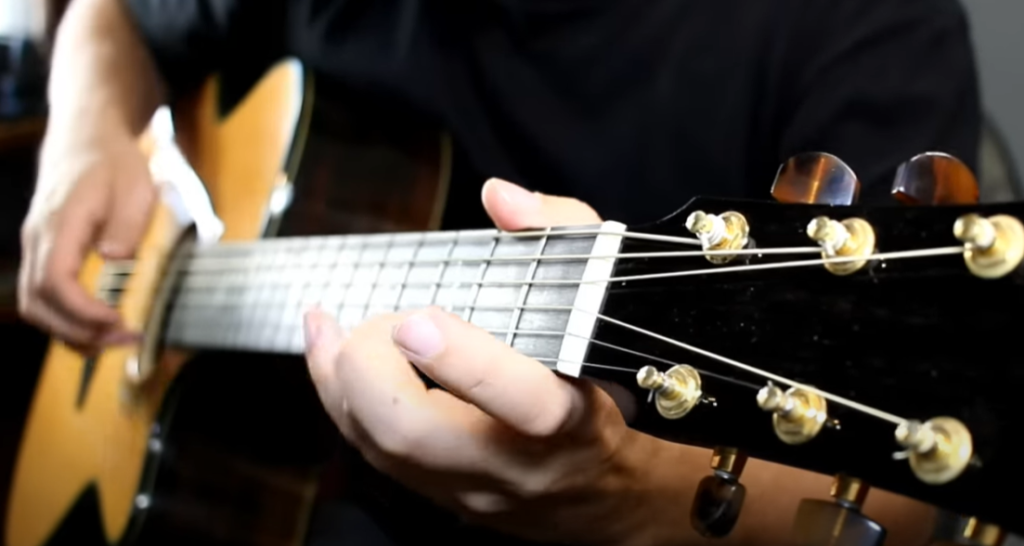
What Are The 3 Most Used Guitar Chords?
Out of the numerous guitar chords at your disposal, three that are used most often are C Major, A Minor, and G Major. All of these chords are effortless to play and often serve as the foundation for countless popular tunes. Strum a beautiful C major chord on your guitar by using the index finger to press down the 3rd fret of the A string, middle finger to hold down 2nd fret of D string and ring finger for pressing 3rd fret of E string.
To form the G major chord, begin by placing your index finger on 3rd fret of the 6th string (E string), followed by your middle finger to press down on 2nd fret of 5th string (A String) and ending with your ring finger pressed onto 3rd fret of 1st string (B String).
Once you have learned these chords, you can use them in a variety of popular songs. Playing these three chords will open up a world of possibilities when it comes to playing guitar. With practice, you will be able to play many more chords as well!
The good news is that learning these three simple chords does not take much time. So, break out your guitar and start strumming away at these chords! You will be surprised how quickly you can master them and open up a world of possibilities in the world of guitar playing. [6]
The CAGED System
It is a popular guitar chord system used by beginner and experienced players alike. It uses five basic chords, C A G E and D to form any major or minor chord shape on the fretboard. This system makes it easy to move between different keys and provides a great foundation for learning more complex chords. It also helps visual learners break down the fretboard into manageable parts.
The CAGED system can be broken down into two main parts: the root note and the intervals (tones) within each chord. The root note is typically your starting point when forming a chord shape, as this establishes which key you’re in. Intervals are then added around that root note to complete a full chord tone structure, such as major thirds, perfect fourths, and fifths. This gives the player an understanding of what intervals make up the chord and makes it easier to move between different shapes on the fretboard.
The CAGED system also helps players develop hand and finger skills by providing a great platform for practicing chords in all keys. The five basic shapes can be used as is or combined with other notes to create more complex chords. With practice, guitarists should find themselves able to quickly switch from one chord shape to another without having to look at the fretboard too closely.
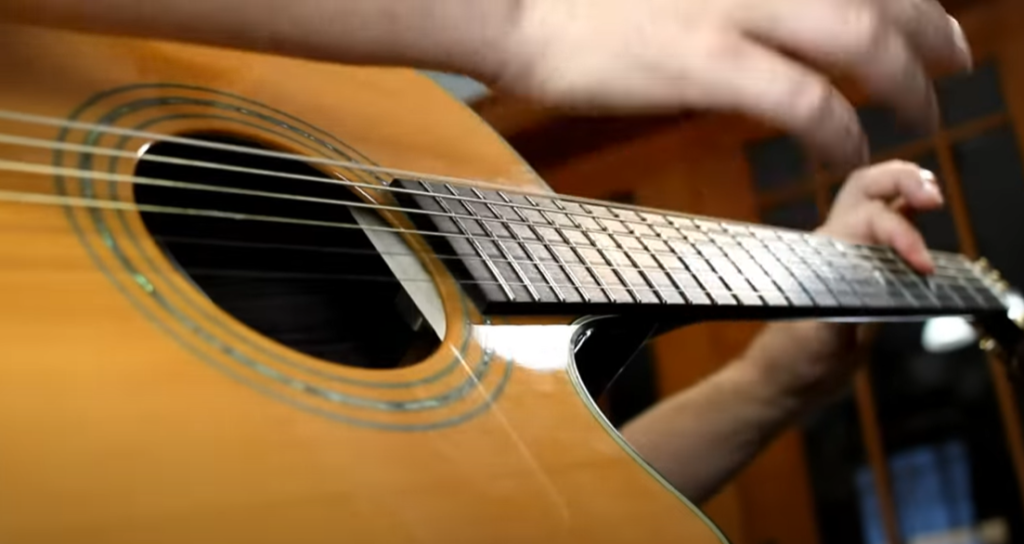
Overall, the CAGED system provides an excellent foundation for any guitarist, whether they are just starting out or have been playing for years. It’s easy to use and helps develop essential skills that will help beginners and experienced players alike. With practice, guitarists should find themselves able to quickly switch from one chord shape to another without having to look at the fretboard too closely. The CAGED system is an invaluable tool for any guitarist and should not be overlooked.
By taking advantage of this system, you can quickly learn how to play chords in all keys and eventually become a master of the fretboard! [7]
Is Guitar Easy to Learn?
Guitar is a popular instrument that many people choose to learn, but is it easy to learn? The answer depends on the individual and how much time they are willing to dedicate to learning.
Aside from learning chords, another important aspect of playing guitar is developing technique. Developing good finger placement, posture, strumming patterns and other techniques takes time and practice. Learning how to read music is also key to becoming an accomplished guitarist.
In summary, guitar can be easy or difficult to learn depending on the individual’s dedication and skill level. With patience and perseverance, anyone can become a proficient guitarist with enough practice and effort.
Learning guitar is definitely possible – as long as you have the right attitude determination! Regular practice that focuses on technique, theory, and fundamentals will help you become a better guitar player in no time.
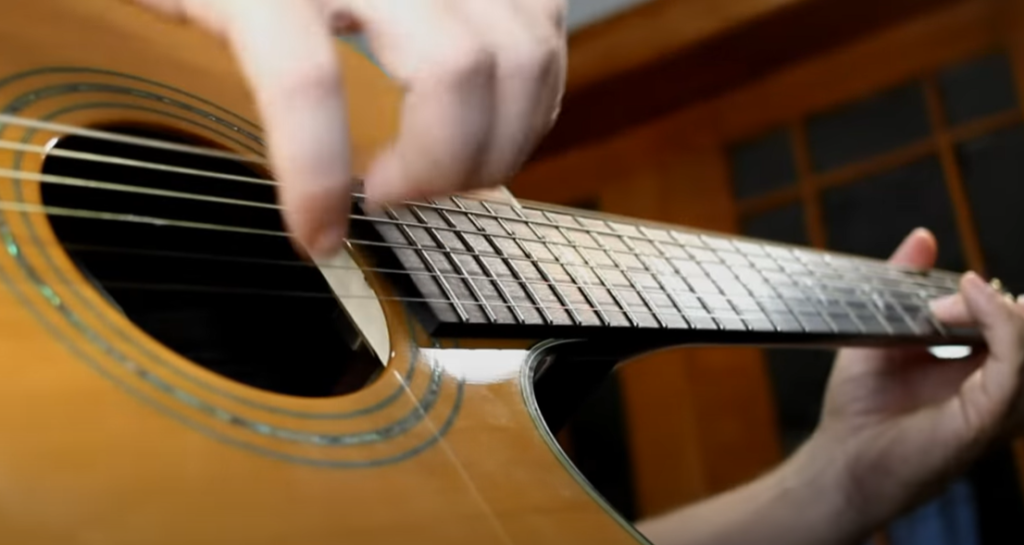
Best Methods For Learning To Play Guitar
Playing guitar chords can be an intimidating prospect for beginners, but with a little practice and dedication, you will soon achieve success. Here are some of the best methods for learning to play guitar chords:
- Work on exercises that focus solely on your chord playing technique. Start by practicing essential open chords such as E major, A major and D major, along with some basic barre chords and variations like Fmaj7 or C9. These simple and common guitar chords are great foundations to build upon as you progress in your guitar playing career.
- Learn songs! Play Alongs are a great way to start learning how to use the most common guitar chords while also putting them into a musical context. Play Alongs are recordings of famous songs that have the vocal and guitar solo part removed, so you can practice playing the chords.
- Don’t forget to strum! Once you have your chords down, it’s time to add some rhythm to them by learning and practicing different strumming patterns. Strumming is essential for giving your chord progressions life and will help give definition to your playing.
- Utilize technology! There are a number of apps available on mobile devices or computer programs where you can create virtual guitar fretboards with interactive diagrams of the chords and scales used in songs – these tools can be an invaluable aid when it comes to learning how to play new material quickly and efficiently.
Learning how to play guitar chords is a process that requires time and dedication, but with these tips and methods you can become an expert in no time! So get practicing and have fun!
Can You Teach Yourself Guitar At Home?
Absolutely! You can absolutely teach yourself guitar at home. It may take a little more time and effort, but it’s totally possible! The most important thing is to have patience and a dedicated practice schedule. Start by learning the basics like open chords and barre chords, then learn some of the most common guitar chords such as E major, A major and D major.
Once you understand these basics, start playing along to play alongs or songs that utilize these basic chords. As you progress, move on to learning scales and more complex chord structures.
In addition to hands-on practice with your guitar, there are also helpful tools such as guitar fretboard apps which allow you to visualize how a particular song works with interactive diagrams of chords and scales. Utilizing these tools can help you learn new material quickly and in a more efficient manner. With consistent practice and dedication, you’ll be playing guitar like a pro in no time!
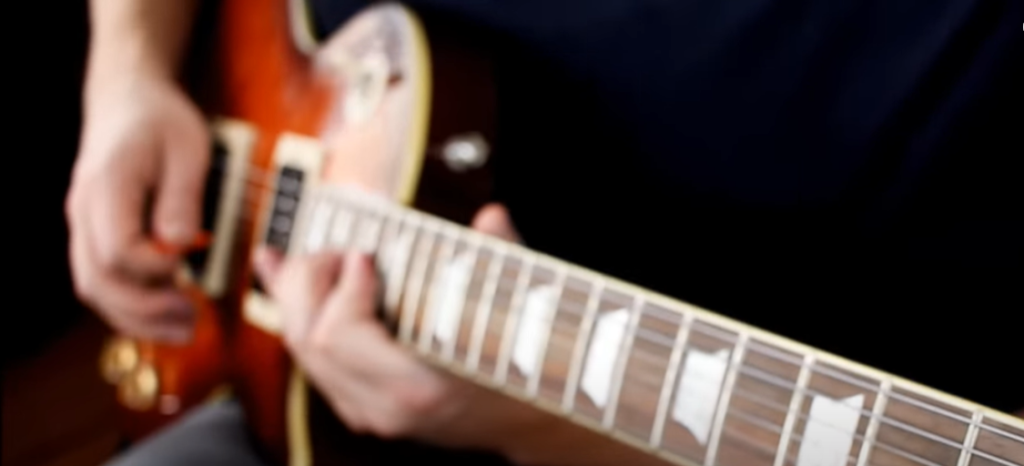
Can I Learn To Play Guitar Quickly?
Yes, it is possible to learn how to play guitar quickly if you have the right approach. First and foremost, it’s important to set realistic expectations for yourself; learning an instrument takes time and effort regardless of your initial skill level. Also, remember that practice makes perfect- so make sure to dedicate at least 20 minutes each day to practicing your chords and scales. Start by focusing on the most basic chords such as E major, A major and D major, then move on to learning more complex chords. Finally, take advantage of technology and utilize guitar fretboard apps that give interactive diagrams of how a particular song works. With these tips and dedication, you will be able to learn how to play guitar quickly!
What Not To Do When Learning to Play Guitar?
When learning to play guitar, it is important to remember that there are certain things you should not do. Here are some of the most common mistakes made by inexperienced guitar players:
- Not Using a Metronome: A metronome can help you stay in time and keep your strumming patterns steady. This can be especially helpful when playing complex chords or progressions.
- Playing Too Fast: It is easy to try to play faster than you can handle, but this will only lead to sloppy playing and frustration. Instead, focus on mastering the basics first before attempting more advanced techniques or pieces.
- Skipping Steps: Learning any new skill requires patience and dedication — guitar is no different. Make sure to take the time to master each step before moving on to something more challenging.
- Trying To Learn Too Many Chords At Once: Learning chords is essential for any guitarist, but trying to learn too many at once can be overwhelming and will likely lead to confusion and frustration. Try learning a few chords at a time and practice them until you have them memorized.
- Not Practicing Proper Technique: Bad habits are hard to break, so make sure you take the time to learn proper technique from the beginning. This includes everything from hand position, to strumming patterns, and even how you hold the guitar itself!
- Not Following A Lesson Plan: Learning to play guitar can often seem like an overwhelming task that requires too much thought and effort. That’s why it is important to come up with a practice plan and stick to it. Even if it is something as simple as spending 30 minutes each day practicing chords and progressions, having a plan helps keep you focused and motivated.
- Not Experimenting with Your Music: As you gain more experience playing the guitar, try experimenting with different styles or genres of music. This can help you develop new skills and open up opportunities for collaboration with other musicians in your area or online. It also helps keep the creative process fresh and exciting.
Learning to play guitar can be a very rewarding experience, but it is important to approach it with patience and dedication. By avoiding these common mistakes, you will no doubt have a more enjoyable journey as you learn this timeless instrument! [8]
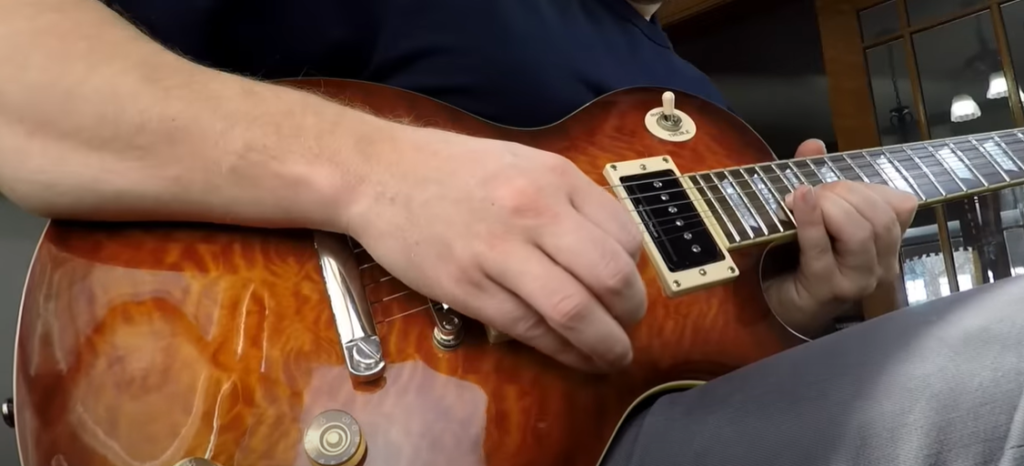
Which Guitar Style is Easiest?
The most common guitar chords are the same regardless of which style you choose, so learning them is essential no matter what style you’re playing. However, certain genres have different fingerings and techniques that can make them easier for some players.
For example, if you want to learn blues or classic rock styles on guitar, then the easiest way may be to use open chords (like E, A, D major etc.) as they are much simpler to finger than barre chords. Folk music often relies heavily on strumming and is perfect for beginner guitarists who are still developing their rhythm skills.
If jazz is more your style, then learning how to play 7th chords will be key – but once you’ve mastered that, the improvisation aspect of it makes for a really rewarding experience. Similarly, learning to play slide guitar is also great for blues and country music.
Overall, as long as you dedicate time to practice different chords and techniques, you can become an expert player no matter which genre or style you choose! So don’t be discouraged if one style doesn’t feel natural right away – keep at it and soon enough you’ll find the genre that suits your playing best. [9]
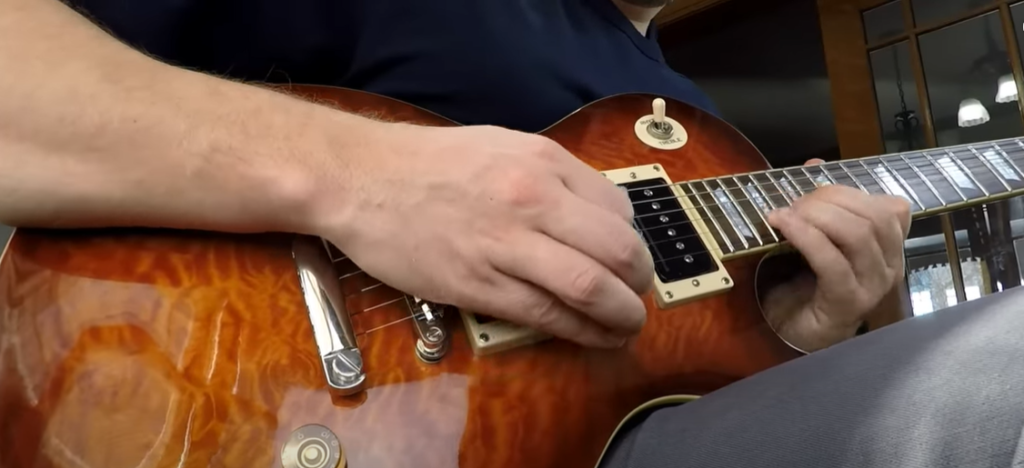
Which Guitar is Difficult?
Guitarists often ask which chords are the most difficult to play. While there is no definitive answer, some chords may require a bit more practice than others.
The G major chord can be one of the toughest for beginners; its shape spans five frets and requires you to use all four fingers of your fretting hand. Barre chords involve pressing down on multiple strings with one finger and require very precise finger positioning.
Minor 7th chords, in particular, can be tricky due to their complex structure that involves both minor 3rds and major 7ths intervals.
No matter which chords you choose to learn, the most important thing is that you practice regularly and focus on mastering your technique. With regular practice and dedication, even the toughest chords can be conquered.
Mastering the Most Common Guitar Chords: Finger Placement and Common Usage
Unlock the world of guitar playing by learning the most common chords used in various songs. This comprehensive table provides you with finger placement instructions and common usage scenarios for each chord.
| Chord | Finger Placement | Common Usage |
|---|---|---|
| C Major (C) | Place your index finger on the 1st fret of the 2nd (B) string, middle finger on the 2nd fret of the 4th (D) string, and ring finger on the 3rd fret of the 5th (A) string. | Common in folk and pop music. |
| G Major (G) | Place your index finger on the 2nd fret of the 5th (A) string, middle finger on the 3rd fret of the 6th (E) string, and ring finger on the 3rd fret of the 2nd (B) string. | Found in rock, country, and pop songs. |
| D Major (D) | Place your index finger on the 2nd fret of the 3rd (G) string, middle finger on the 2nd fret of the 1st (high E) string, and ring finger on the 3rd fret of the 2nd (B) string. | Used in various genres, including rock and blues. |
| A Minor (Am) | Place your index finger on the 1st fret of the 2nd (B) string, middle finger on the 2nd fret of the 4th (D) string, and ring finger on the 2nd fret of the 3rd (G) string. | Common in ballads and acoustic music. |
Explanation of the Table:
- Chord: Lists the common guitar chord names.
- Finger Placement: Provides step-by-step instructions on where to place your fingers for the chord.
- Common Usage: Describes the musical scenarios in which each chord is commonly used.
Learning these chords with their finger placement and common usage will enhance your guitar playing skills:
C Major (C): This chord is often used in folk and pop music, and mastering it is a great starting point for beginners.
G Major (G): Common in rock, country, and pop songs, this chord is a versatile addition to your repertoire.
D Major (D): Found in various genres, including rock and blues, this chord adds depth to your playing.
A Minor (Am): Frequently used in ballads and acoustic music, this minor chord offers a melancholic tone.
With this detailed information, you’ll be well on your way to mastering the most common guitar chords and expanding your musical repertoire.
FAQ
What are the 3 most used guitar chords?
The three most common guitar chords are G Major, C Major, and D Major. These are the basic open position major chords used in many popular songs such as “Smoke on the Water” by Deep Purple and “Wonderwall” by Oasis.
What is an open chord?
An open chord is a type of guitar chord played with one or more strings left “open” (not fretted). Open chords can be played anywhere up and down the neck of the guitar but are most often found in first position. This means that each string is fretted at, or near to, the first fret.

What is a barre chord?
A barre chord is a type of guitar chord where one finger is used to press down all the strings at once on a single fret. This creates a chord that sounds fuller and louder than chords created with open strings. Barre chords are most commonly used in rock, blues, and folk music but can be incorporated into many other genres of guitar playing. Some of the most common barre chord shapes include E major, A major, D major, G major, C major, A minor, and D minor. Each of these chords requires the guitarist to use their first finger as a “barre” across all six strings of the guitar. The challenge with barre chords is that they require strength and agility in the hand; it takes time to build up the necessary muscles in order to play them properly. Additionally, the guitarist may need to adjust their hand position in order to shift between different barre chords and open strings.
What is the hardest chord to learn?
The hardest chord to learn on the guitar is often considered to be an F major barre chord. This chord requires accuracy and strength in finger placement, as well as endurance since it takes more effort than other chords. It’s important for aspiring guitarists to practice this chord until they are comfortable with playing it in a variety of different keys. Additionally, it’s beneficial to use a capo while practicing this chord; placing a capo at the fifth fret will make some shapes easier and can help build up strength in the hand faster. With enough practice and dedication, any guitarist can learn how to play F major barre chords!
Is playing guitar good for your brain?
Absolutely! Playing guitar is a great way to exercise your brain and improve your focus. It can help with coordination, timing, and problem-solving skills. Additionally, learning how to play chords or read music requires memorization, which can increase cognitive development. Lastly, playing an instrument can be incredibly calming and therapeutic; it’s been known to reduce stress levels and improve overall mental well-being. So yes – playing guitar is definitely good for the brain!
What chord does Ed Sheeran use?
Many of Ed Sheeran’s songs, such as “Shape of You” and “Photograph,” use the most common guitar chord progression: I-V-vi-IV. This means that he uses the chords C major (I), G major (V), A minor (vi), and F major (IV). He often plays these chords in a different order, but they all appear in his music. Additionally, Sheeran frequently adds another chord to this progression, such as an Em or Bm. Knowing these basic chords can help you play many of his popular songs more easily!
Is guitar harder than piano?
That is a difficult question to answer since it largely depends on the individual preferences and abilities of each musician. Generally speaking, playing the guitar can require more physical coordination than playing the piano as it involves finger dexterity and hand-eye coordination, which may be more challenging for certain individuals. Additionally, learning guitar chords often requires memorizing several chord shapes and their corresponding notes, whereas many piano songs only require learning one or two chord patterns. On the other hand, some musicians might find reading music notation easier on a piano than on a guitar due to its linear layout compared to the strings of a guitar. Ultimately, there is no definitive answer as to whether one instrument is harder than another – everyone has different skill sets that may make one instrument more difficult or easier than the other.
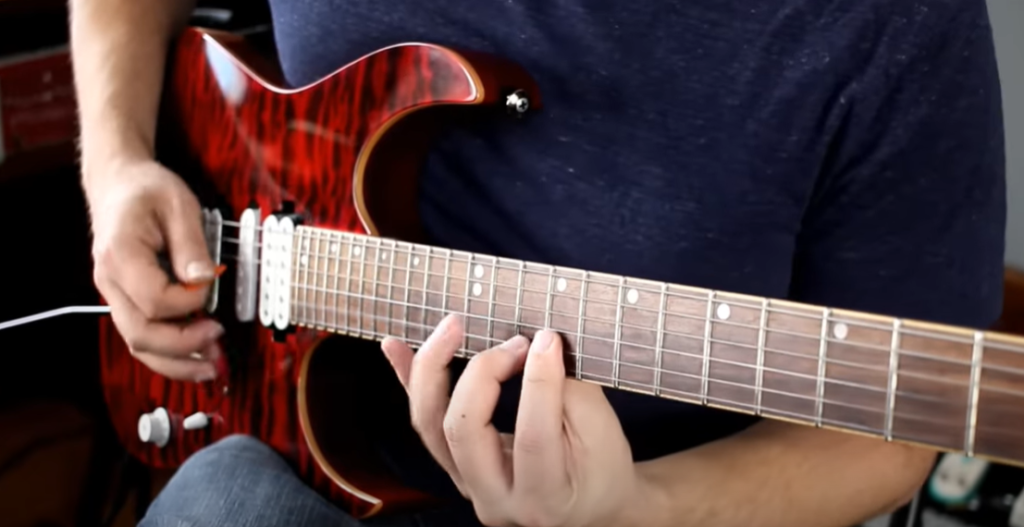
Which hand is harder for the guitar?
The answer to this question depends largely on the individual and their level of guitar skill. Generally, it can be said that the left hand is more challenging to use since it is responsible for fretting notes and chords. For beginners, it may be difficult initially to get a consistent sound as they press down on strings with the left hand. Additionally, changing between chords quickly and accurately can also be a challenge for new players. With practice, however, most people find that their left hand becomes much easier to control over time. The right hand then becomes more of focus as players attempt to develop fluidity, speed, and accuracy in strumming or picking patterns. Overall, both hands are important components of playing guitar and require practice and dedication in order to become proficient. Whether the left or right hand is more challenging for guitar playing may vary from person to person, but it’s important to remember that both hands are equally essential and can be developed through consistent practice and dedication.
Is it OK to learn guitar on electric?
Absolutely! While acoustic guitars may seem more traditional, due to their louder volume and mellow sound, electric guitars are often easier for beginners. Electric guitars make it easier to learn because they require less finger strength and pressure to press down the strings. Plus, electric guitars can be plugged into amplifiers and pedals which give you access to a larger range of tones than an acoustic guitar would. Learning on an electric guitar is a great option for aspiring guitarists who want a fun challenge that yields satisfying results.
What is the best age to learn electric guitar?
The best age to learn electric guitar is subjective and depends on your individual situation. Generally speaking, it’s never too early or late to start learning guitar. Kids as young as 6 or 7 can be introduced to the basics of electric guitar playing with an instructor who is experienced in teaching children. If you’re older, there are no restrictions either – many adults begin their journey into playing the electric guitar later in life. Starting out when you’re younger will give you more time to practice and hone your skills, which can be beneficial for anyone wanting to become a professional musician. However, starting out later in life can provide unique insight due to maturity, which could help increase creativity and open up new possibilities. Whichever route you prefer, there are no restrictions on the age you should begin playing electric guitar. With enough dedication and practice, anyone of any age can learn how to play electric guitar!
Is guitar easier than keyboard?
The answer to this question depends on the individual and their own unique experience with each instrument. Generally speaking, guitar is often perceived as being easier to play than keyboard due to its smaller fingerboard and easier chord shapes. Many beginning guitar players learn basic open chords like C, G, D and A very quickly because of the simplified fingering patterns required for those chords. On the other hand, a keyboard can present a bit more of a challenge for beginners due to its wider range of notes. In order to play chords on a keyboard one must be able to identify all of the notes in that chord which can take some time before it becomes second nature. Additionally, playing chords on keyboard often requires two hands since both hands are needed in order to sound all the notes of a chord at once.
What are the basic open chords every guitarist should learn?
Basic open chords like C, D, E, A, and G are essential for beginners. These chords form the foundation for many songs and are typically the first chords taught to new guitarists.
How can I transition smoothly between common guitar chords?
Smooth chord transitions require practice. Start by working on chord changes that are common in the songs you want to play. Use a metronome to maintain a steady rhythm and practice switching between chords until it becomes effortless.
What are power chords, and how are they different from standard chords?
Power chords are chords that consist of only the root note and the fifth note of a scale. They are commonly used in rock and punk music for their simple, powerful sound. Unlike standard chords, they lack a major or minor quality, making them versatile for playing with distortion or overdriven tones.
Can you explain the importance of the CAGED system in learning chords?
The CAGED system is a method to understand and visualize common chord shapes on the guitar neck. It’s based on five open chord shapes: C, A, G, E, and D. This system helps guitarists navigate the fretboard, allowing them to play various chord inversions and progressions more easily.
What are some common chord progressions used in popular songs?
Common chord progressions include I-IV-V, I-V-vi-IV, and ii-V-I. These progressions appear in countless songs across different genres. Learning them will enable you to play a wide range of music.
How can I add embellishments to basic chords to make my playing more interesting?
Adding embellishments like hammer-ons, pull-offs, and slides can add flavor to your chord playing. Experiment with these techniques to create variations on standard chords and make your guitar playing more dynamic and expressive.
What are some common chord shapes for playing in alternate tunings?
Common alternate tunings like Open D and Open G have specific chord shapes that work well. For example, in Open D, a D major chord can be played by simply strumming all the open strings. Exploring alternate tunings can open up new chord possibilities.
How do I practice and master barre chords, which are more challenging than open chords?
Barre chords require strength and finger dexterity. Start by practicing on the first fret and gradually work your way up the neck. Ensure your thumb placement is correct behind the neck and practice barring all the strings with even pressure.
What are some common chord voicings for jazz guitar playing?
Common jazz chord voicings include major 7th, minor 7th, dominant 7th, and diminished chords. Learning these voicings and their inversions is crucial for playing jazz standards and improvising in the jazz genre.
How can I use a capo to change the key of a song without changing the chord shapes?
A capo is a handy tool that allows you to raise the pitch of all the strings on your guitar. By placing it on different frets, you can change the key of a song while using the same chord shapes. This is particularly useful for singers looking to adjust the song to a more comfortable vocal range.
Useful Video: 8 Guitar Chords You Must Know – Beginner Guitar Lessons
Conclusion
Guitar chords are an essential part of guitar playing. Learning the basics is a great way to get started, and mastering them will lead to more advanced playing. There are many different types of chords available, each with its own unique sound and feel. By learning the most common guitar chords, you can begin exploring and creating new music on your own. With practice and dedication, you’ll be able to strum away in no time!
Good luck!
References:
- https://play-guitars.com/guitar-chords-for-beginners/
- https://theacousticguitarist.com/the-most-common-guitar-chords/
- https://www.guitartricks.com/blog/Basic-Guitar-Chords
- https://www.musicgrotto.com/basic-guitar-chords/
- https://www.imusic-school.com/en/tools/guitar-chords/beginner/
- https://takelessons.com/blog/2015/03/the-ten-best-tips-and-tricks-for-learning-guitar-chords
- https://appliedguitartheory.com/lessons/caged-guitar-theory-system/
- https://www.libertyparkmusic.com/10-beginner-guitar-mistakes/
- https://www.justinguitar.com/guitar-lessons/what-s-the-best-guitar-for-a-beginner-bc-010




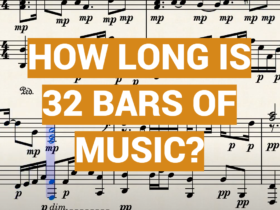
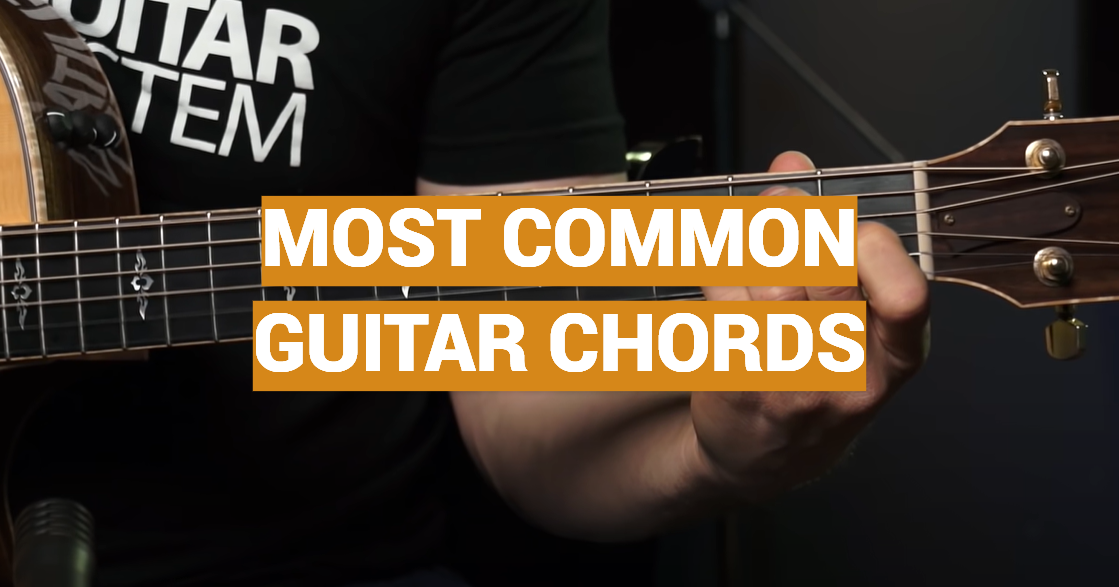




Leave a Reply